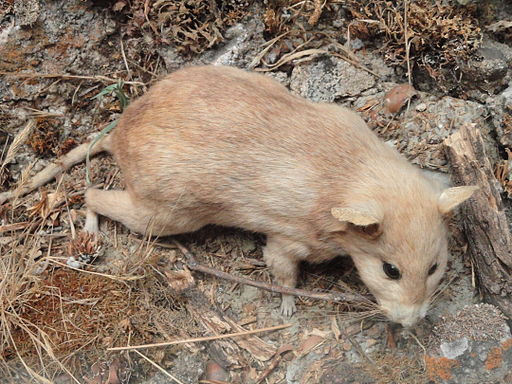SERVICE REQUEST?
Fill out the form below.
Find our nearest location
Your Local Office

Pack Rat
Attribution: Daderot, [CC0 or CC0], via Wikimedia Commons
Size:
Medium-sized rodents whose bodies measure about eight inches, with the tail slightly shorter than the head and body combined.
Color:
Varies in color from cinnamon to brown, gray, yellowish gray, or creamy buff, depending on the species and specimen. The underside is clearly more lightly colored than the upper part of the rat.
Behavior:
Pack rats get their name from their habit of taking small, bright or shiny objects and hoarding them in their nests. They will take beer can tabs, bottle caps, bits of foil, coins, and jewelry just to name a few items. Often, sticks or nuts the rat was carrying at the time are left at the site where the shiny object was acquired, thus the additional nickname of “trade” rat. They are mainly nocturnal creatures but may be active during the day. After establishing themselves within a building, pack rats will feed on foods within the building but will continue to forage for most of their food outdoors.
Pack rats occur throughout the United States except in a few states around the Great Lakes and the northeastern United States. These rats tend to be more of a problem in buildings in the western part of the country. Most species of pack rats are excellent climbers and some are actually semi-arboreal in preference — meaning they will nest in trees. Others are ground nesters and will dig burrows in which to live. Numerous rats may occupy a single den.
The best ways to avoid invasions of pack rats are to (1) provide as little harborage as possible that might attract rodents, and (2) seal as many holes and cracks in the outside of the home through which rats might enter. Follow these recommendations to help prevent pack rats from seeking the food and shelter provided by your home:
- Keep firewood stored as far from the home as possible and store it off the ground. During the winter, store only enough wood next to the house to burn every couple of days.
- If possible, remove any piles of debris, stones, bricks, etc. If these are near the foundation of the home they serve as harborages to attract rodents. Once there, it is an easy step for rodents to enter the building itself.
- Seal any hole or crack larger than 1/4 of an inch. Large holes or cracks should be stuffed with steel wool or wire mesh before sealing with caulk or foam, otherwise rodents could chew through to enter.
- Install a good, thick weather-stripping on the bottom of all doors to prevent rodents from entering. The garage door may prove difficult to seal completely, so the door from the garage to the house must be sealed tightly.
- Remember, your Terminix service includes coverage of commensal rats and mice, and much of the service provided during the colder months is to inspect for signs of rodents and to maintain preventive control measures.
Although not a significant health threat, pack rats are associated with a number of diseases that infect humans, including plague and lyme disease. For this reason, dead rats should never be handled using bare hands, and care should be taken to avoid their ectoparasites, especially fleas and ticks.
Family Name:
Neotoma spp.
Read What Our Clients
Are Saying
My Terminix tech Scott is the best! He is professional, courteous and absolutely thorough about his job. Thank you for sending such a blessed tech to my house. Hamlet, NC
This letter is to say how pleased we are here at Morreene West Apartments with your services. We are very pleased with the technician, Christopher. He does a great job. Durham, NC
Terminix has consistently offered our apartment complex reliable, competent service. We are completely satisfied with their knowledgeable representative who is always punctual and does a superior job for us every time. Chapel Hill, NC
I would like to take the time to thank you for giving us such great service here at Carver Pond Apartments. Your Pest Technician Christopher Mitchell has provided us with excellent service over the last few months. Christopher is such a great help to us in providing helpful information so that we can better serve our residents here at Carver Pond. Durham, NC
SERVICE REQUEST?
Fill out the form below.